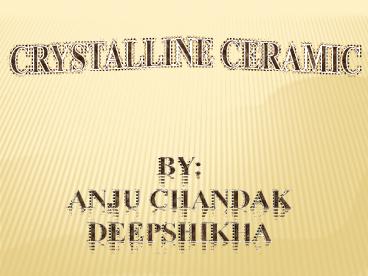crystalline ceramic - PowerPoint PPT Presentation
Title:
crystalline ceramic
Description:
ceramic can be classified as two types crystalline ceramic and non-crystalline ( amorphous ) – PowerPoint PPT presentation
Number of Views:3641
Title: crystalline ceramic
1
CRYSTALLINE CERAMIC
BY ANJU CHANDAK DEEPSHIKHA
2
Crystalline Ceramics
- As with plastics, the amorphous ceramics tend to
be transparent - The structural ceramics tend to be crystalline
and show greater strength, as well as stability
at high temperature
3
AX Structure - CsCl
- Cl-
Note This is not a BCC structure.
Cs
Simple Cubic Crystal
4
AX Structure - NaCl
2- FCC interpenetrating lattices.
5
AX Structure - ZnS
6
Silicate Ceramics
- Silica, SiO2
- Many polymorphsQuartz CrystobaliteTridymite
- Low density Quartz 2.65g/cm3
7
Crystalline Crystabolite
8
Carbon
- Pure carbon has many polymorphs with vastly
varying properties. It also exists in the
amorphous state. - Diamond Is similar to ZnS in structure
- Graphite is considered to be a crystalline
ceramic - Fullerenes, C60, are a newly discovered polymorph
- with interesting properties.
9
Diamond
- AX type crystal structure similar
- to that of ZnS.
- Each carbon atom is covalently bonded to four
other C atoms in a diamond-cubic crystal
structure. - The material is optically transparent and
extremely hard (hardest natural material known)
and durable. - In engineering applications, cruder or industrial
forms of diamond, that are much less expensive
than the gemstone forms, are used as abrasives,
indentors, and coatings (especially thin films)
for a variety of applications.
10
Graphite
- Layers of hexagonally arranged and
- covalently bonded C atoms.
- Between layers, weaker Van der Walls
- bonds are active, giving easy slip
- on the 0001 crystallographic planes.
- Excellent as a dry lubricant, relatively high
strength at elevated temperatures, high thermal
and electrical conductivity, low thermal
expansion, resistance to thermal shock, and good
machinability. - Usage electrodes, heating elements, crucibles,
casting molds, rocket nozzles, and other
applications.
11
Fullerenes, C60
- Molecular form of carbon with a
- hollow spherical structure resembling
- a geodesic dome (soccer ball.)
- Called buckyballs after R. Buckminister
- Fuller, who pioneered the geodesic dome.
- Discovered in 1985 and have since been found to
occur naturally in several sources. - In the solid crystalline state, C60 molecules
pack together in a FCC unit cell arrangement with
a lattice parameter a1.41 nm. - The pure solid material density is about 1.65
g/cm3 and it is relatively soft and is
non-conducting since it has no free electrons.
12
Try It!
- Calcualte the theoretical density of pure C60
based on a FCC unit cell as shown
a1.41 nm
13
Defects in Crystalline Ceramics
- Vacancy
- Interstitial
- Dislocation
- Grain Boundary
Cation Interstitial Anion Vacancy Cation
Vacancy Schotky Defect Frenkel Defect
Electro- neutrality
14
Mechanical Properties
- Brittle Materials, hard to perform a Tension
Test. - Flexural Test (Bend) is often substituted.
- Obtain Flexural Strength (Modulus of Rupture),
Stiffness (Modulus of Elasticity), and Ductility. - Strength is often good, Stiffness my be high, but
Ductility and affected properties are poor. - In crystalline ceramics, dislocation motion is
difficult because of the need to maintain
electro-neutrality. Consequently plastic
deformation is restricted.
15
Stress-Strain Behaviour
16
Hardness of Ceramics
17
Effect of Porosity on Stiffness
Where Eo is the theoretical modulus of elasticity
with no porosity, and P is the volume fraction of
porosity.
18
Effect of Porosity on Strength
- Where so is the theoretical modulus of rupture
with no porosity, P is the volume fraction of
porosity, and n is an empirical material constant
19
Fracture Toughness
20
Amorphous Ceramics - Glasses (Na20, Ca0, K2O, etc)
- The viscosity of the material at ambient
temperature is relatively high, but as the
temperature increases there is a continuous
decrease in viscosity. - When the viscosity has decreased to the point
that the ceramic is a fluid, it is considered to
have melted. - At ambient temperature while it is still solid,
it is said to be in the glassy condition. - There is no distinct melting temperature (Tm) for
these materials as there is with the crystalline
materials. - The glass transition temperature, Tg, is used to
define the temperature below which the material
is a solid and defines a practical upper limit
on service temperature.
21
Specific volume of amorphous and crystalline
ceramics.
22
Viscous Behaviour in Amorphous Ceramics
t shear stress h viscosity of material
- Plastic deformation does not occur by
dislocation motion in amorphous or
non-crystalline ceramics, such as glass. - Deformation is by viscous flow rate of
deformation proportional to applied stress.
23
Ceramic Phase Diagrams
- Note They are similar to metal alloy systems -
except the temperatures are generally higher.
24
ANY QUERY???
25
THANKS FOR YOUR ATTENTION































